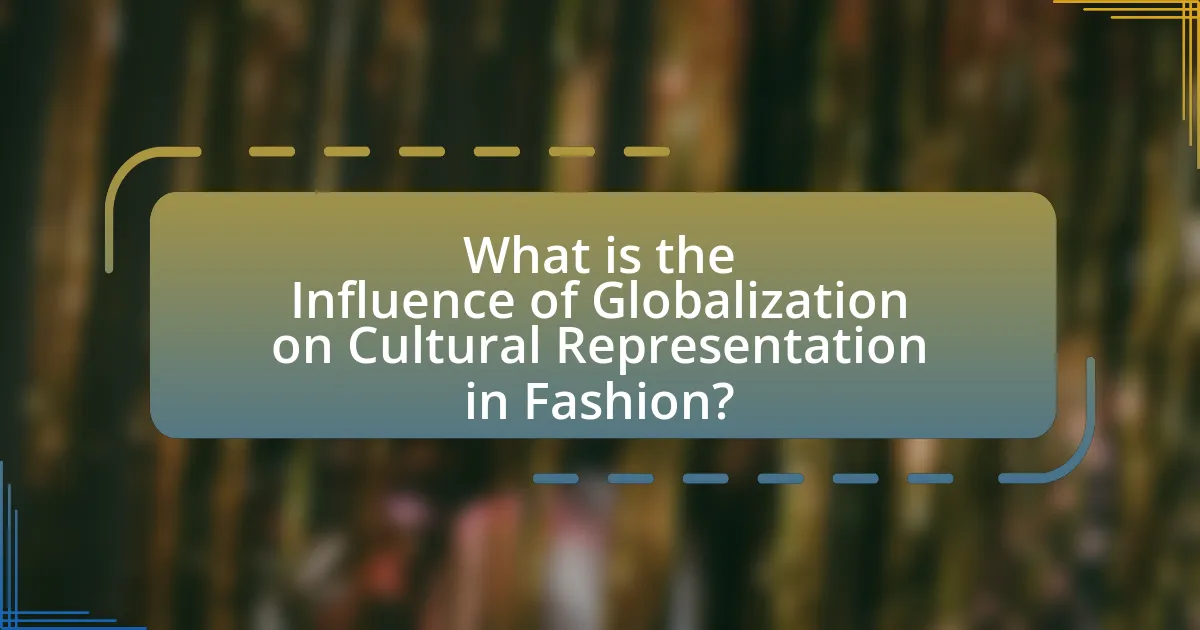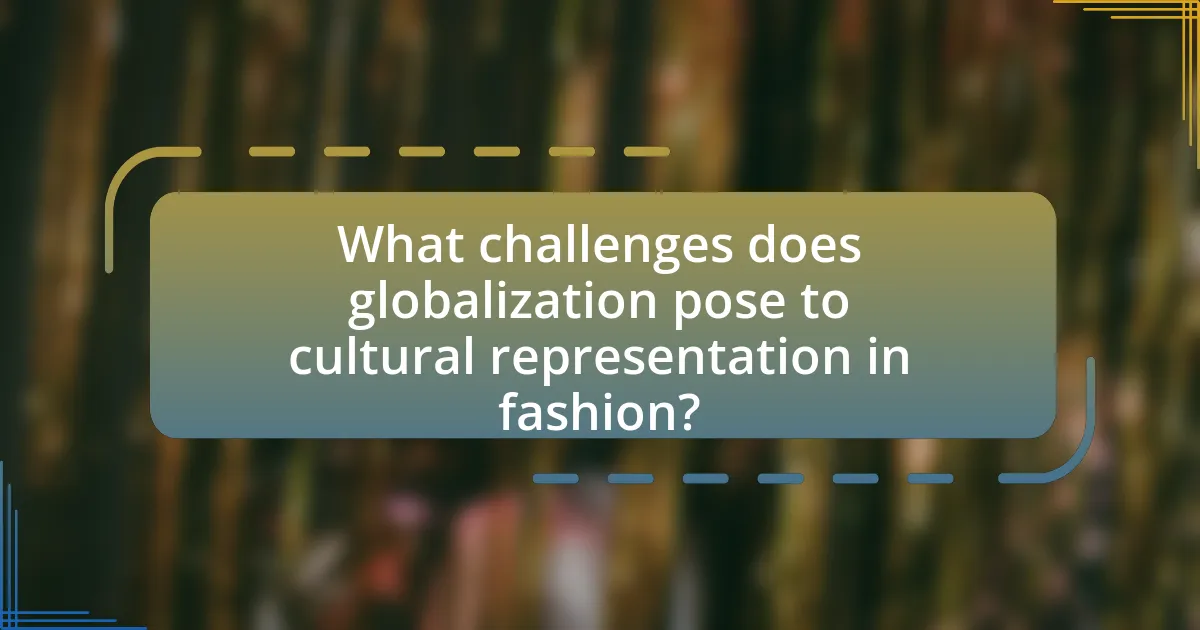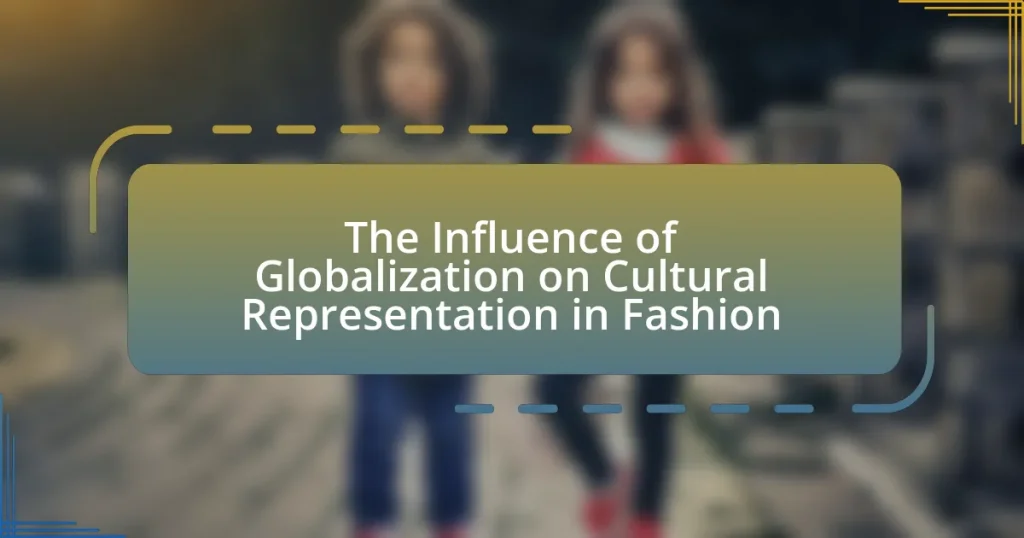The article examines the influence of globalization on cultural representation in fashion, highlighting how interconnectedness facilitates the exchange of diverse cultural ideas and styles. It discusses the transformation of the fashion industry through global supply chains, the rise of fast fashion, and the implications of cultural appropriation versus appreciation. Key factors driving globalization, such as technological advancements and cultural exchange, are analyzed alongside the importance of authentic representation and the role of consumerism. The article also addresses the challenges posed by globalization, including the risk of homogenization and misrepresentation of cultural identities, while emphasizing the need for ethical practices and collaboration with marginalized communities to enhance cultural sensitivity in fashion.

What is the Influence of Globalization on Cultural Representation in Fashion?
Globalization significantly influences cultural representation in fashion by facilitating the exchange of ideas, styles, and practices across diverse cultures. This interconnectedness allows designers to draw inspiration from various cultural elements, leading to a fusion of traditional and contemporary styles. For instance, the rise of streetwear has incorporated motifs from African, Asian, and Indigenous cultures, reflecting a blend of global influences. Additionally, globalization has enabled brands to reach international markets, often resulting in the appropriation of cultural symbols without proper acknowledgment or respect. This phenomenon raises concerns about cultural commodification, where unique cultural identities may be diluted or misrepresented in mainstream fashion. The impact of globalization on fashion is evident in the increasing visibility of diverse cultural expressions, but it also necessitates a critical examination of authenticity and representation in the industry.
How has globalization changed the fashion industry?
Globalization has transformed the fashion industry by facilitating the rapid exchange of styles, trends, and cultural influences across borders. This interconnectedness allows designers to draw inspiration from diverse cultures, leading to a more eclectic and inclusive fashion landscape. For instance, the rise of fast fashion brands like Zara and H&M exemplifies how global supply chains enable quick production and distribution of clothing, making international trends accessible to consumers worldwide. Additionally, according to a 2020 report by McKinsey & Company, the global fashion market was valued at approximately $2.5 trillion, highlighting the significant economic impact of globalization on the industry. This shift has also raised awareness of cultural appropriation, prompting discussions about ethical representation and the importance of honoring the origins of cultural motifs in fashion.
What are the key factors driving globalization in fashion?
The key factors driving globalization in fashion include technological advancements, international trade agreements, and cultural exchange. Technological advancements, such as the internet and social media, enable brands to reach global audiences instantly, facilitating the spread of fashion trends across borders. International trade agreements lower tariffs and barriers, allowing for easier import and export of textiles and garments, which enhances global supply chains. Cultural exchange, driven by travel and migration, introduces diverse styles and influences, leading to a fusion of fashion that reflects a globalized culture. These factors collectively contribute to the interconnectedness of the fashion industry worldwide.
How do global supply chains impact cultural representation?
Global supply chains significantly impact cultural representation by facilitating the global exchange of fashion ideas and practices, which can lead to both cultural appropriation and appreciation. The interconnectedness of markets allows brands to source materials and labor from diverse cultures, often resulting in the blending of traditional designs with contemporary styles. For instance, the rise of fast fashion has led to the commercialization of indigenous patterns and motifs without proper acknowledgment or compensation, as seen in cases involving brands like Zara and their use of traditional Mexican designs. This dynamic can dilute the original cultural significance and context, leading to a misrepresentation of the culture in the global marketplace.
Why is cultural representation important in fashion?
Cultural representation is important in fashion because it fosters inclusivity and diversity, allowing various cultural identities to be acknowledged and celebrated. This representation not only enriches the fashion industry by introducing unique aesthetics and narratives but also promotes social awareness and understanding among different communities. For instance, the rise of multicultural fashion shows and collaborations has led to increased visibility for designers from underrepresented backgrounds, which can drive consumer engagement and brand loyalty. According to a 2020 study by the Council of Fashion Designers of America, brands that embrace cultural diversity in their campaigns see a 30% increase in customer engagement, highlighting the economic benefits of cultural representation in fashion.
What role does cultural identity play in fashion choices?
Cultural identity significantly influences fashion choices by shaping individual preferences, styles, and the meanings attached to clothing. This influence manifests through traditional garments, symbols, and colors that reflect cultural heritage and values. For instance, the use of specific patterns or textiles, such as African kente cloth or Japanese kimono fabrics, often conveys cultural narratives and personal identity. Research indicates that individuals often select fashion items that resonate with their cultural background, reinforcing a sense of belonging and community. A study published in the Journal of Fashion Marketing and Management highlights that consumers are more likely to purchase clothing that aligns with their cultural identity, demonstrating the strong connection between culture and fashion choices.
How can misrepresentation affect communities and cultures?
Misrepresentation can significantly distort the perceptions and identities of communities and cultures. When cultural elements are inaccurately portrayed in fashion, it can lead to stereotypes that undermine the complexity and richness of those cultures. For instance, the appropriation of traditional attire without understanding its significance can trivialize cultural heritage, as seen in instances where indigenous designs are commercialized without acknowledgment or respect. This not only perpetuates harmful stereotypes but also erodes the authenticity of cultural expressions, leading to a loss of cultural pride and identity among community members. Research indicates that such misrepresentation can result in social fragmentation, as marginalized groups may feel alienated or misrepresented in broader societal narratives, ultimately affecting their social cohesion and cultural continuity.
What are the positive effects of globalization on cultural representation in fashion?
Globalization positively affects cultural representation in fashion by facilitating the exchange of diverse cultural elements, leading to greater inclusivity and innovation. This exchange allows designers to draw inspiration from various cultural traditions, resulting in a richer and more varied fashion landscape. For instance, the incorporation of traditional textiles and patterns from different cultures into contemporary designs has become increasingly common, as seen in collections by brands like Stella McCartney and Gucci, which often feature global influences. Additionally, globalization enables fashion brands to reach wider audiences, promoting cultural appreciation and understanding through fashion shows and collaborations that highlight diverse cultural narratives. This trend not only enhances the visibility of underrepresented cultures but also fosters a dialogue about cultural heritage and identity within the global fashion community.
How does globalization promote cultural exchange in fashion?
Globalization promotes cultural exchange in fashion by facilitating the flow of ideas, styles, and trends across borders. This interconnectedness allows designers and brands to draw inspiration from diverse cultural backgrounds, leading to the fusion of traditional and contemporary elements in clothing. For instance, the rise of streetwear has incorporated influences from various cultures, such as Japanese aesthetics and African patterns, creating a global fashion dialogue. Additionally, international fashion weeks and online platforms enable designers from different regions to showcase their work, further enhancing cross-cultural interactions. This exchange not only enriches the fashion landscape but also fosters greater appreciation and understanding of different cultural identities.
What examples exist of successful cultural collaborations in fashion?
Successful cultural collaborations in fashion include the partnership between Louis Vuitton and Takashi Murakami, which merged high fashion with contemporary art, resulting in the iconic Monogram Multicolore collection. Another example is the collaboration between Adidas and Beyoncé’s Ivy Park, which celebrates Black culture and empowerment through inclusive designs. Additionally, the collaboration between H&M and designer Isabel Marant brought Parisian chic to a global audience, showcasing how cultural aesthetics can be democratized. These collaborations illustrate how fashion can bridge cultural divides and create impactful narratives.

What challenges does globalization pose to cultural representation in fashion?
Globalization poses significant challenges to cultural representation in fashion by homogenizing diverse cultural expressions and often leading to cultural appropriation. The widespread reach of global fashion brands can dilute unique cultural identities, as traditional garments and motifs are reinterpreted or commercialized without proper context or respect for their origins. For instance, the appropriation of Indigenous designs by mainstream fashion labels has sparked controversy, highlighting the lack of acknowledgment and compensation for the original cultures. Additionally, the dominance of Western fashion standards can marginalize local artisans and traditional practices, resulting in a loss of cultural heritage. This dynamic is evident in the rise of fast fashion, which prioritizes profit over authentic representation, further complicating the landscape of cultural expression in the fashion industry.
How does cultural appropriation manifest in the fashion industry?
Cultural appropriation in the fashion industry manifests through the adoption and commercialization of elements from marginalized cultures without permission or understanding. This often includes the use of traditional clothing, symbols, or designs in mainstream fashion, which can lead to misrepresentation and commodification of those cultures. For example, high-fashion brands have faced backlash for using Native American headdresses as fashion accessories, which disregards their cultural significance and sacredness. Additionally, the lack of representation of the original cultures in the design process highlights the power imbalances and exploitation inherent in cultural appropriation.
What are the consequences of cultural appropriation for marginalized cultures?
Cultural appropriation has significant negative consequences for marginalized cultures, including the erasure of cultural identity and the commodification of sacred symbols. When dominant cultures adopt elements from marginalized cultures without understanding or respecting their significance, it often leads to misrepresentation and distortion of those cultures. For instance, the use of Native American headdresses as fashion accessories disregards their cultural importance and the historical context of their use in ceremonies, which can perpetuate stereotypes and reinforce power imbalances. Additionally, marginalized communities may experience economic disadvantages, as they are often excluded from the profits generated by their cultural expressions when appropriated by others. This dynamic can further entrench systemic inequalities and hinder the cultural and economic empowerment of these communities.
How can the fashion industry address issues of appropriation?
The fashion industry can address issues of appropriation by implementing ethical sourcing practices and fostering genuine collaborations with marginalized cultures. Ethical sourcing involves obtaining permission and respecting the cultural significance of designs, which can prevent exploitation. For instance, brands like Stella McCartney have established partnerships with Indigenous artists to create collections that honor their heritage, ensuring that cultural elements are represented accurately and respectfully. Additionally, educating designers and consumers about cultural sensitivity can promote awareness and appreciation rather than appropriation, as seen in initiatives like the Fashion Institute of Technology’s programs on cultural representation. These steps can help create a more inclusive and respectful fashion landscape.
What impact does consumerism have on cultural representation?
Consumerism significantly influences cultural representation by prioritizing marketable identities over authentic cultural expressions. This phenomenon often leads to the commodification of cultural symbols, where elements of diverse cultures are appropriated and commercialized without proper context or respect. For instance, fashion brands frequently adopt traditional garments or motifs from various cultures, transforming them into trendy items that may misrepresent their original significance. A study by the American Anthropological Association highlights that such practices can dilute cultural meanings and reinforce stereotypes, as they reduce complex identities to simplistic, consumable forms. Thus, consumerism shapes cultural representation by favoring superficial interpretations that cater to market demands rather than fostering genuine cultural understanding.
How do fast fashion trends affect traditional cultural garments?
Fast fashion trends significantly undermine traditional cultural garments by promoting mass production and homogenization of styles. This rapid cycle of trend creation often leads to the appropriation of cultural elements without proper context or respect, diluting their original significance. For instance, traditional garments like the kimono in Japan or the sari in India are increasingly being reproduced in cheaper materials and styles that do not honor their cultural heritage. According to a study published in the Journal of Fashion Technology & Textile Engineering, the rise of fast fashion has resulted in a 400% increase in clothing consumption over the past two decades, which directly impacts the authenticity and craftsmanship associated with traditional attire. This shift not only threatens the survival of these garments but also contributes to a loss of cultural identity as unique styles are replaced by generic, trend-driven designs.
What role do consumers play in shaping cultural representation in fashion?
Consumers play a crucial role in shaping cultural representation in fashion by influencing trends and demanding authenticity in brand narratives. Their purchasing decisions reflect cultural values and preferences, which brands must acknowledge to remain relevant. For instance, the rise of sustainable fashion is driven by consumer demand for ethical practices, prompting brands to incorporate diverse cultural elements that resonate with their audience. This shift is evidenced by the increasing popularity of brands like Patagonia and Stella McCartney, which emphasize environmental and social responsibility, aligning with consumer expectations for cultural sensitivity and representation.

How can the fashion industry improve cultural representation in a globalized world?
The fashion industry can improve cultural representation in a globalized world by actively collaborating with diverse designers and communities to ensure authentic representation. This approach not only amplifies underrepresented voices but also fosters a more inclusive narrative within the industry. For instance, brands like Gucci and Dior have partnered with local artisans and cultural experts to create collections that reflect genuine cultural heritage, thereby enhancing authenticity and respect for different cultures. Additionally, implementing diversity in hiring practices and decision-making roles can lead to more culturally aware and sensitive designs, as evidenced by the increased visibility of Black and Indigenous designers in major fashion weeks.
What strategies can brands adopt for better cultural representation?
Brands can adopt strategies such as collaborating with diverse cultural consultants and employing inclusive marketing practices to enhance cultural representation. By engaging cultural experts, brands ensure authentic representation that resonates with various communities, thereby avoiding stereotypes. Research indicates that brands that prioritize diversity in their marketing teams see a 20% increase in customer engagement, highlighting the effectiveness of inclusive practices. Additionally, brands can conduct thorough market research to understand the cultural nuances of their target demographics, which further supports accurate representation and fosters brand loyalty.
How can collaboration with local artisans enhance authenticity?
Collaboration with local artisans enhances authenticity by integrating traditional craftsmanship and cultural narratives into fashion products. This partnership allows designers to incorporate unique techniques and materials that reflect the local heritage, thereby creating items that resonate with genuine cultural significance. For instance, brands that work with artisans often showcase handmade processes, which not only preserve age-old skills but also tell a story that mass-produced items cannot convey. Research indicates that consumers increasingly value authenticity, with a 2019 study by the Boston Consulting Group revealing that 70% of consumers are willing to pay a premium for products that are perceived as authentic. This demonstrates that collaboration with local artisans not only enriches the product’s cultural value but also aligns with market demand for authenticity in fashion.
What are the benefits of inclusive marketing practices?
Inclusive marketing practices enhance brand loyalty, broaden market reach, and foster innovation. By representing diverse demographics, brands resonate with a wider audience, leading to increased customer engagement and loyalty. Research indicates that companies with inclusive marketing strategies can see a revenue increase of up to 30%, as they appeal to underrepresented groups. Furthermore, inclusive marketing encourages creativity and innovation by integrating varied perspectives, which can lead to unique product offerings and solutions. This approach not only reflects societal values but also positions brands as leaders in social responsibility, ultimately driving long-term success.
What role does education play in promoting cultural sensitivity in fashion?
Education plays a crucial role in promoting cultural sensitivity in fashion by equipping designers and industry professionals with the knowledge of diverse cultural practices and values. This understanding fosters respect and appreciation for different cultures, which is essential in a globalized fashion landscape. For instance, educational programs that include multicultural studies and ethical fashion practices encourage students to critically analyze the implications of cultural appropriation and the importance of representation. Research by the Fashion Institute of Technology highlights that curricula incorporating cultural awareness lead to more inclusive design practices, ultimately benefiting both the industry and the communities it represents.
How can fashion schools incorporate cultural representation into their curricula?
Fashion schools can incorporate cultural representation into their curricula by integrating diverse cultural perspectives and practices into their design courses. This can be achieved through collaborations with artisans from various cultural backgrounds, allowing students to learn traditional techniques and understand the cultural significance behind them. For instance, programs can include workshops led by indigenous designers or partnerships with organizations that promote cultural heritage in fashion. Research indicates that exposure to diverse cultural narratives enhances creativity and innovation in design, as seen in studies highlighting the benefits of multicultural education in fostering a broader understanding of global fashion trends.
What initiatives exist to raise awareness about cultural representation in fashion?
Initiatives that raise awareness about cultural representation in fashion include organizations like the Fashion Diversity Network, which promotes inclusivity and diversity within the industry. Additionally, campaigns such as #BlackLivesMatter and #StopAsianHate have sparked discussions on cultural appropriation and representation, leading to increased scrutiny of fashion brands. Events like the annual Diversity in Fashion Summit also focus on educating industry professionals about the importance of cultural sensitivity and representation. These initiatives are supported by research indicating that diverse representation can enhance brand loyalty and consumer engagement, as highlighted in studies by the Council of Fashion Designers of America.
What practical steps can consumers take to support cultural representation in fashion?
Consumers can support cultural representation in fashion by choosing to purchase from brands that prioritize diversity and inclusivity in their designs and marketing. By actively seeking out and supporting designers from underrepresented cultures, consumers can help amplify their voices and promote authentic cultural expressions. Additionally, consumers can engage in conversations about cultural appropriation and advocate for ethical practices in the fashion industry, encouraging brands to collaborate with cultural representatives rather than exploit their heritage. Research indicates that 67% of consumers prefer brands that demonstrate a commitment to diversity, highlighting the market demand for culturally representative fashion.














